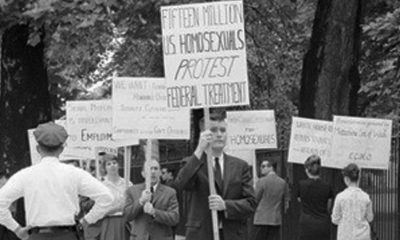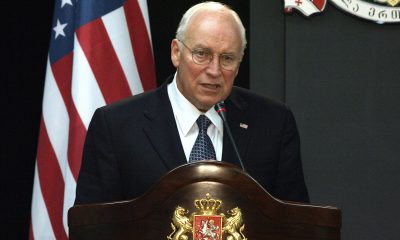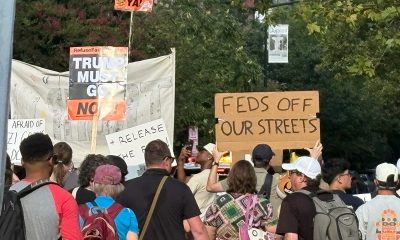Local
Covering Frank Kameny
A reporter’s 35-year journey chronicling the nation’s preeminent gay activist
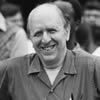
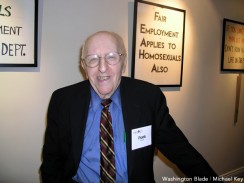
Frank Kameny served as a colorful, reliable source for the Blade and other news outlets during his decades of activism. (Washington Blade photo by Michael Key)
I met Frank Kameny for the first time in the summer of 1974 at a meeting in Washington of the Gay Activists Alliance, now the Gay and Lesbian Activists Alliance.
At 24 years old, I had just landed my first job as a reporter covering the energy and environment beat for a company that published newsletters specializing in reporting on government regulations.
With an undergraduate degree in political science and a year’s worth of graduate studies in journalism under my belt, I walked into that GAA meeting at D.C.’s Quaker Meeting House near Dupont Circle knowing next to nothing about gay rights, gay politics or the gay community.
In the process we know as coming out, I had come to terms with myself as a gay man just months earlier.
So with that as a backdrop, I listened intently to the main topic of the meeting — reports of arrests of gay men at cruising areas by undercover officers assigned to the D.C. police vice squad.
Most of the arrests were not linked to sex in public places, one of the members reported. The men, whom the GAA member described as consenting adults, were merely seeking to meet one another for a sexual tryst or perhaps a lasting friendship that was to take place in the privacy of their homes, not in the public areas where they met.
But in an action I learned later was a routine practice throughout the country at that time, the undercover officers reportedly posed as willing participants and enticed the gay men into “soliciting” them to engage in sodomy, which was a criminal offense that led to an arrest. In some cases the undercover officers used body language suggesting they were inviting the men to touch them in a sexually suggestive way.
If the men took the bait and touched the officers, they were charged with committing a lewd act, a development that could ruin their careers, especially if they worked for the government.
After listening to these reports, a man appearing in his late 40s or early 50s with a booming voice and an obvious thorough knowledge of the issue at hand mapped out a strategy for GAA’s and the gay community’s response: The entrapment arrests of gay men would be portrayed as an “utter” waste of taxpayer’s money and police resources at a time when “real” crime was running rampant in the city.
This self-assured man, who I quickly learned was gay rights pioneer Frank Kameny, raised his voice to emphasize each of his points, attracting the attention of a maintenance worker in the hallway outside the room. He said police officials were unresponsive to earlier requests to stop the entrapment arrests and it was time to take another course of action.
Kameny said GAA should enlist community allies to help it lobby the City Council to eliminate city funding for the vice squad, which was known at the time as the Prostitution, Perversion, and Obscenity (PPO) Branch.
“It’s an outrage and an injustice,” I recall him saying. “We’re citizens of this city. The police, like all government officials, are public servants. And public servants answer to us.”
Much to my amazement, within a year or two, the City Council, voted to eliminate from the police budget funding for the PPO Branch. Although some of its work in the area of prostitution continued, the police practice of entrapment of gay men soon came to an end.
I was naïve and uninformed on the nuances of the gay rights movement when I attended that meeting in 1974. But I knew a good news source when I saw one.
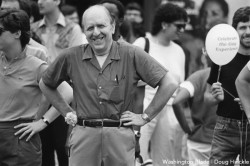
Frank Kameny become known for his sense of humor during his long activist career and feared his tactics would get him disbarred if he had decided to pursue a law degree. (Washington Blade photo by Doug Hinckle)
Frank Kameny over the next 25 years or more was to become my preeminent news source in my coverage of the LGBT community as a reporter for the Washington Blade.
From the start, I had the good fortune of getting to know Frank Kameny and getting a crash course from him on the history of the gay movement and its current struggles and aspirations.
Since Kameny’s death last week, much has been written about his vast contribution to the LGBT movement over a 50-year period, especially in the decade before the Stonewall rebellion of 1969, which is viewed as the starting point of the modern gay movement.
What hasn’t been reported as widely is Kameny’s impact on the lives of individual lesbians, gay men, and transgender people whom he helped and with whom he interacted. His self-confident and assertive demeanor on behalf of the rights of all LGBT people and his unyielding spirit for fighting injustice – no matter how great the odds appeared to be – came across to those around him.
I’ll never forget the story told to me by a gay man I met at a GAA meeting about six months after that first meeting I attended in the summer of 1974. Appearing in his 40s, the man told me he was born and raised in a conservative, fundamentalist Christian household in southern Virginia and had struggled to accept his homosexuality. He said five years of psychotherapy upon moving to the D.C. area had little effect in helping shake his inner struggles over his sexual orientation.
He said his meeting Kameny and other activists at GAA meetings, and subsequent weekly phone conversations with Kameny on a wide range of issues over a period of months, boosted his self-confidence to a degree that he could never attain in years of therapy.
“I fired my therapist,” he told me while smiling broadly “Frank and the other folks here gave me the insight to understand that the external forces of discrimination and oppression and homophobia are what got me down,” I recall him saying.
Kameny’s assistance to individual LGBT people blossomed in his role as a paralegal counsel representing gays encountering problems with security clearances in the late 1960s through the 1980s. When his clients were comfortable going public with their case, Kameny provided me with copies of his legal briefs challenging actions by various U.S. government agencies, often the Defense Department, seeking to deny or revoke a gay person’s security clearance.
Those targeted for loss of a clearance usually worked for the government or for a private company doing contract work for the government. The main argument used for revoking a clearance was that gay people were susceptible to blackmail and were thus a threat to the safeguarding of government secrets.
Kameny often argued that the government had yet to disclose a single case where a gay person breached government secrets due to blackmail or coercion related to his or her sexual orientation.
He noted that government security officials appeared to be obsessed with the private sex lives of gays holding security clearances. In the course of investigating a gay person over a clearance, security officials demanded to know the identities of all of their sex partners over a period of years and insisted they reveal the specific types of sexual acts the gay person performed with his or her partners.
Kameny’s characteristic response to these inquires surfaced in a 1969 case in which he represented a New York gay man named Benning Wentworth, whose application for a clearance was opposed by the government solely on grounds of his status as a “sexually active” homosexual.
“We state to the world, as we have stated for the public, we state for the record and, if the [Defense] Department forces us to carry the case that far, we state for the courts that Mr. Wentworth, being a healthy, unmarried, homosexual male, 35 years old, has lived, and does live a suitable homosexual life, in parallel with the suitable active heterosexual sexual life lived by 75 percent of our healthy, unmarried, heterosexual males holding security clearances,” Kameny stated in a government hearing to adjudicate Wentworth’s clearance application.
Added Kameny, “Mr. Wentworth will get his clearance as the sexually active homosexual that he is and that he will continue to be…just as heterosexuals get their clearances as sexually active heterosexuals.”
He won many of his cases when, at his suggestion, his clients submitted letters disclosing their sexual orientation to co-workers and family members, eliminating, in Kameny’s assessment, any chance of blackmail threats to reveal the client’s homosexuality.
Some of his clients and fellow activists urged Kameny to get his law degree and become a lawyer, noting that he already knew more about the field of security clearance law than most lawyers. He told me his becoming a lawyer would tie his hands, saying the sometimes outlandish tactics he used would get him disbarred.
“They can’t disbar me if I’m not a member of the bar,” he often said.
In cases where he represented members of the military under investigation for being gay in the years prior to “Don’t Ask, Don’t Tell,” Kameny was blunt about the only means of preventing a discharge: “Lie through your teeth,” he told his clients, or refuse to answer any questions about your sexual orientation.
In one of his military cases in the 1980s, Kameny was scheduled to attend a hearing to discuss planned action by the Army to discharge a service member who was identified as being gay by an acquaintance who was pressured into “snitching” on his fellow service member, as Kameny put it.
For some reason, Army officials insisted on meeting with the service member in private, saying Kameny couldn’t attend that particular session, in which the service member was to be “interviewed,” Kameny said.
As a gesture of protest, Kameny placed his foot in the doorway of the meeting room, preventing one of the officials from closing the door. He backed down after being threatened with arrest, saying the gesture was intended to emphasize his strong opposition to the closed meeting.
His use of fiery language as well as humor often surfaced in his testimony before public hearings held by governmental bodies, including the D.C. City Council.
In the early 1990s, Kameny testified before a D.C. Council committee deliberating over a proposed alley closing sought by Georgetown University to clear the way for construction of a new law school building located near the U.S. Capitol.
Gay activists, led by Kameny and GAA, called on the Council to withhold approval of the alley closing and thus prevent construction of the building until the university ended its policy of refusing to recognize gay student groups on campus.
Shortly after beginning his testimony, Kameny opened his briefcase and pulled out a spray can that he identified as a room deodorizer. He pressed down on the nozzle, spraying a mist in the direction of the Council members seated about 10 feet in front of him.
The “stench of discrimination” being carried out by Georgetown University against gay student groups cannot continue, he said, drawing laughter from the Council members and the audience in the hearing room.
Kameny also directed his sense of humor toward anti-gay organizations, which he closely monitored. On several occasions during the 1980s and 1990s he rushed to the city’s office of corporations and created his own corporation under the exact name of an anti-gay group, preventing the group from setting up its own corporation to do business in D.C.
Although he’s known mostly for his work in the LGBT rights movement, Kameny contributed his talents to other progressive causes. He became the first open gay to be appointed to a prominent city post in the 1970s, when Walter Washington, the city’s first mayor under D.C.’s newly acquired home rule government, named Kameny to the D.C. Commission on Human Rights.
In the early 1980s, Kameny won election to the D.C. Statehood Constitutional Convention and played a lead role in drafting a constitution for the proposed State of New Columbia.
During all of his years as an activist and movement leader in which I had the privilege to cover him, Kameny excelled as a news source in more stories than I can count. Thank you, Frank. You’ll be sorely missed.
Virginia
DOJ seeks to join lawsuit against Loudoun County over trans student in locker room
Three male high school students suspended after complaining about classmate
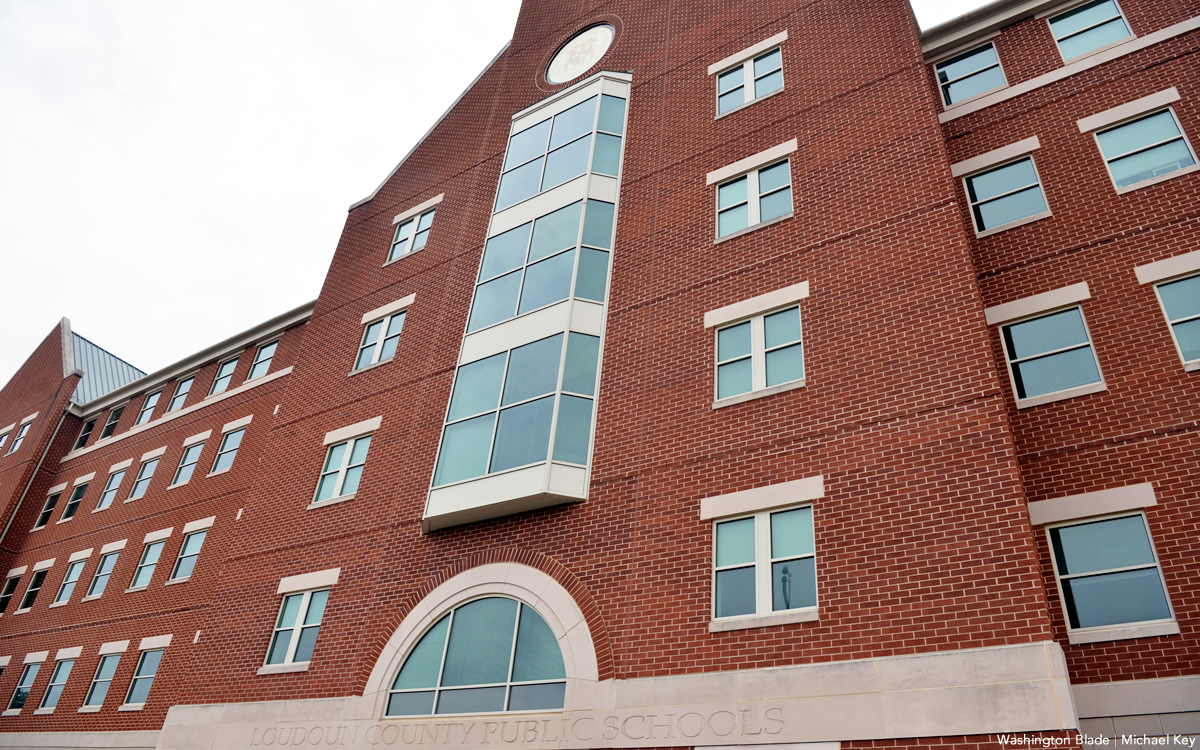
The Justice Department has asked to join a federal lawsuit against Loudoun County Public Schools over the way it handled the case of three male high school students who complained about a transgender student in a boys’ locker room.
The Washington Blade earlier this year reported Loudoun County public schools suspended the three boys and launched a Title IX investigation into whether they sexually harassed the student after they said they felt uncomfortable with their classmate in the locker room at Stone Bridge High School in Ashburn.
The parents of two of the boys filed a lawsuit against Loudoun County public schools in U.S. District Court for the Eastern District of Virginia in Alexandria. The Richmond-based Founding Freedoms Law Center and America First Legal, which White House deputy chief of staff Stephen Miller co-founded, represent them.
The Justice Department in a Dec. 8 press release announced that “it filed legal action against the Loudoun County (Va.) School Board (Loudoun County) for its denial of equal protection based on religion.”
“The suit alleges that Loudoun County applied Policy 8040, which requires students and faculty to accept and promote gender ideology, to two Christian, male students in violation of the Equal Protection Clause of the 14th Amendment to the U.S. Constitution,” reads the press release.
Assistant Attorney General Harmeet K. Dhillon of the Justice Department’s Civil Rights Division in the press release said “students do not shed their First Amendment rights at the schoolhouse gate.”
“Loudoun County’s decision to advance and promote gender ideology tramples on the rights of religious students who cannot embrace ideas that deny biological reality,” said Dhillon.
Outgoing Virginia Gov. Glenn Youngkin and outgoing Virginia Attorney General Jason Miyares in May announced an investigation into the case.
The Virginia Department of Education in 2023 announced the new guidelines for trans and nonbinary students for which Youngkin asked. Equality Virginia and other advocacy groups claim they, among other things, forcibly out trans and nonbinary students.
The U.S. Department of Education’s Office of Civil Rights in February launched an investigation into whether Loudoun County and four other Northern Virginia school districts’ policies in support of trans and nonbinary students violate Title IX and President Donald Trump’s executive order that prohibits federally funded educational institutions from promoting “gender ideology.”
District of Columbia
Capital Pride announces change in date for 2026 D.C. Pride parade and festival
Events related to U.S. 250th anniversary and Trump birthday cited as reasons for change

The Capital Pride Alliance, the D.C. based group that organizes the city’s annual LGBTQ Pride events, has announced it is changing the dates for the 2026 Capital Pride Parade and Festival from the second weekend in June to the third weekend.
“For over a decade, Capital Pride has taken place during the second weekend in June, but in 2026, we are shifting our dates in response to the city’s capacity due to major events and preparations for the 250th anniversary of the United States,” according to a Dec. 9 statement released by Capital Pride Alliance.
The statement says the parade will take place on Saturday, June 20, 2026, with the festival and related concert taking place on June 21.
“This change ensures our community can gather safely and without unnecessary barriers,” the statement says. “By moving the celebration, we are protecting our space and preserving Pride as a powerful act of visibility, solidarity, and resistance,” it says.
Ryan Bos, the Capital Pride Alliance CEO and President, told the Washington Blade the change in dates came after the group conferred with D.C. government officials regarding plans for a number of events in the city on the second weekend in June. Among them, he noted, is a planned White House celebration of President Donald Trump’s 80th birthday and other events related to the U.S. 250th anniversary, which are expected to take place from early June through Independence Day on July 4.
The White House has announced plans for a large June 14, 2026 celebration on the White House south lawn of Trump’s 80th birthday that will include a large-scale Ultimate Fighting Championship (UFC) event involving boxing and wrestling competition.
Bos said the Capital Pride Parade will take place along the same route it has in the past number of years, starting at 14th and T Streets, N.W. and traveling along 14th Street to Pennsylvania Ave., where it will end. He said the festival set for the following day will also take place at its usual location on Pennsylvania Avenue, N.W., between 2nd Street near the U.S. Capitol, to around 7th Street, N.W.
“Our Pride events thrive because of the passion and support of the community,” Capital Pride Board Chair Anna Jinkerson said in the statement. “In 2026, your involvement is more important than ever,” she said.
District of Columbia
Three women elected leaders of Capital Pride Alliance board
Restructured body includes chair rather than president as top leader
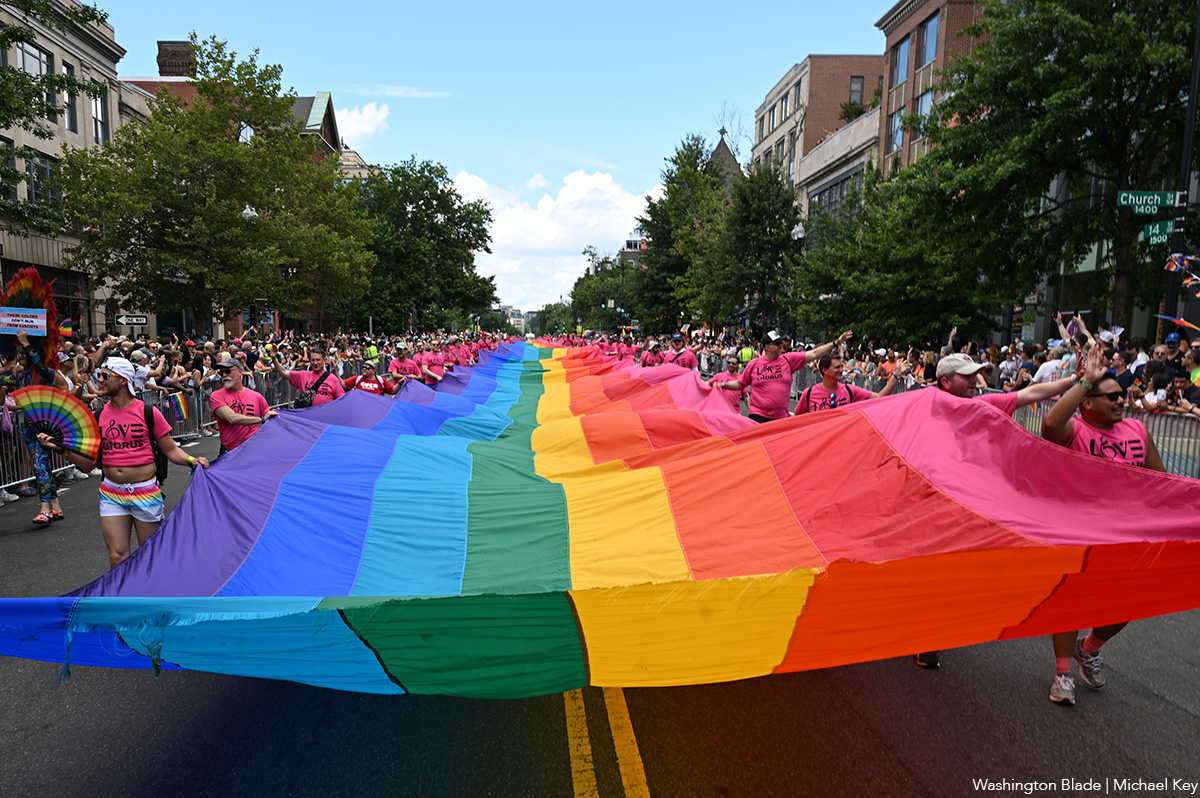
The Capital Pride Alliance, the D.C.-based group that organizes the city’s annual LGBTQ Pride events, announced it has restructured its board of directors and elected for the first time three women to serve as leaders of the board’s Executive Committee.
“Congratulations to our newly elected Executive Officers, making history as Capital Pride Alliance’s first all-women Board leadership,” the group said in a statement.
“As we head into 2026 with a bold new leadership structure, we’re proud to welcome Anna Jinkerson as Board Chair, Kim Baker as Board Treasurer, and Taylor Lianne Chandler as Board Secretary,” the statement says.
In a separate statement released on Nov. 20, Capital Pride Alliance says the restructured Board now includes the top leadership posts of Chair, Treasurer, and Secretary, replacing the previous structure of President and Vice President as the top board leaders.
It says an additional update to the leadership structure includes a change in title for longtime Capital Pride official Ryan Bos from executive director to chief executive officer and president.
According to the statement, June Crenshaw, who served as acting deputy director during the time the group organized WorldPride 2025 in D.C., will now continue in that role as permanent deputy director.
The statement provides background information on the three newly elected women Board leaders.
• Anna Jinkerson (chair), who joined the Capital Pride Alliance board in 2022, previously served as the group’s vice president for operations and acting president. “A seasoned non-profit executive, she currently serves as Assistant to the President and CEO and Chief of Staff at Living Cities, a national member collaborative of leading philanthropic foundations and financial institutions committed to closing income and wealth gaps in the United States and building an economy that works for everyone.”
• Kim Baker (treasurer) is a “biracial Filipino American and queer leader,” a “retired, disabled U.S. Army veteran with more than 20 years of service and extensive experience in finance, security, and risk management.” She has served on the Capital Pride Board since 2018, “bringing a proven track record of steady, principled leadership and unwavering dedication to the LGBTQ+ community.”
• Taylor Lianne Chandler (Secretary) is a former sign language interpreter and crisis management consultant. She “takes office as the first intersex and trans-identifying member of the Executive Committee.” She joined the Capital Pride Board in 2019 and previously served as executive producer from 2016 to 2018.
Bos told the Washington Blade in a Dec. 2 interview that the Capital Pride board currently has 12 members, and is in the process of interviewing additional potential board members.
“In January we will be announcing in another likely press release the full board,” Bos said. “We are finishing the interview process of new board members this month,” he said. “And they will take office to join the board in January.”
Bos said the organization’s rules set a cap of 25 total board members, but the board, which elects its members, has not yet decided how many additional members it will select and a full 25-member board is not required.
The Nov. 20 Capital Pride statement says the new board executive members will succeed the organization’s previous leadership team, which included Ashley Smith, who served as president for eight years before he resigned earlier this year; Anthony Musa, who served for seven years as vice president of board engagement; Natalie Thompson, who served eight years on the executive committee; and Vince Micone, who served for eight years as vice president of operations.
“I am grateful for the leadership, dedication, and commitment shown by our former executive officers — Ashley, Natalie, Anthony, and Vince — who have been instrumental in CPA’s growth and the exceptional success of WorldPride 2025,” Bos said in the statement.
“I look forward to collaborating with Anna in her new role, as well as Kim and Taylor in theirs, as we take on the important work ahead, prepare for Capital Pride 2026, and expand our platform and voice through Pride365,” Bos said.

